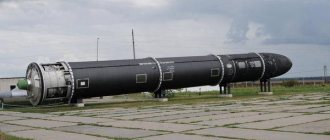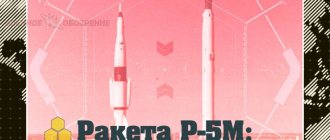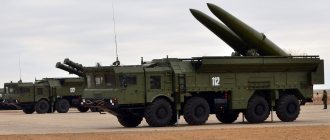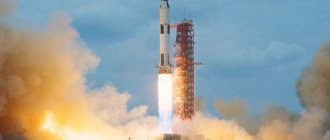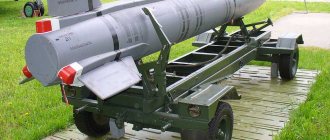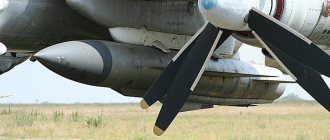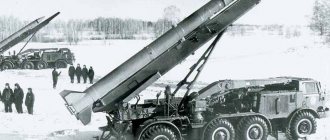BALLISTIC MISSILES, OPERATIONAL-TACTICAL AND TACTICAL
BALLISTIC MISSILES, OPERATIONAL-TACTICAL AND TACTICAL
R -1. 8А11 [SS-1A. SCUNNER]
Tactical ballistic guided missile ((characteristic during the development period - long-range ballistic missile). Created on the basis of the German V-2 (A-4) missile by chief designer Wernher von Braun. The first domestic guided ballistic missile. Parent organization - OKB-1. Chief designer - Sergei Korolev. Leading designer - Alexander Shcherbakov. 13 research institutes and design bureaus, as well as 35 factories took part in the creation of the rocket. Development began in 1947. Flight design tests took place at the Kapustin Yar training ground from 1948 to 1949. 17 The first launch of the first domestic long-range guided missile was carried out on September 1948. The launch was unsuccessful, due to a failure of the control system, the missile deviated from the flight path by almost 500. The first successful launch was made on October 10, 1948. During tests carried out in 1948 10 missiles were launched. During tests carried out in 1949, 20 missiles were launched. The production of missiles was mastered at the pilot plant in Podlipki, the first missiles of this plant were delivered to the customer in June 1952. Serial production from self-made units began on November 28, 1952 at the Southern Machine-Building Plant in Dnepropetrovsk. To operate the rocket, the first missile units in the USSR were created - the Special Purpose Brigades of the Reserve of the Supreme High Command (BON RVGK). Adopted on November 28, 1950. On this day, the 22nd special purpose Gomel brigade of the Orders of Lenin, Red Banner, Orders of Suvorov, Kutuzov and Bogdan Khmelnitsky took up combat duty near the Kapustin Yar training ground in the Astrakhan Region.
R-1
R-1D
Single-stage ballistic missile with an inseparable warhead. Equipped with a propulsion rocket engine using non-storable fuel designed by OKB-456, headed by Valentin Glushko. The ground launch complex was created at GSKB Spetsmash under the leadership of Vladimir Barmin. The control system was developed under the guidance of chief designers Nikolai Pilyugin and Viktor Kuznetsov. Transport units were developed at the Moscow Transport Engineering Design Bureau under the leadership of Anatoly Gurevich.
The maximum firing range is 270 km. Launch weight - 13.4 tons. Rocket length - 14.6 m. Largest body diameter - 1.65 m. Payload weight - 1 t. It had a non-nuclear warhead.
R-2
R-2A
R -2.8Zh38 [SS-2. SIBLING]
Operational - tactical ballistic guided missile ((characteristic during the development period - long-range ballistic missile). Parent organization - OKB-1. Chief designer - Sergei Korolev. Development began in 1948. First launch of the experimental R-2E missile to test the performance of the systems the future R-2 took place on September 21, 1949. Flight design tests took place at the Kapustin Yar training ground from 1949 to 1951. Entered into service on November 27, 1951. Missile production was mastered at the NII-88 pilot plant in Podlipki. Preparations for serial production in Dnepropetrovsk began on November 30, 1951. Serial production was launched at the Southern Machine-Building Plant in Dnepropetrovsk in June 1953. A single-stage ballistic missile with an inseparable warhead. The R-2 complex had a technical and launch position. At the technical position, the missile could be stored in a tent or light protective structure. Equipped with a cruising liquid-propellant rocket engine using non-storable fuel designed by OKB-456, headed by Valentin Glushko. The ground launch complex was created at GSKB Spetsmash under the leadership of Vladimir Barmin. The control system was developed under the guidance of chief designers Nikolai Pilyugin and Viktor Kuznetsov. The radio correction system was developed under the leadership of Mikhail Borisenko. Transport units were developed at the Moscow Transport Engineering Design Bureau under the leadership of Anatoly Gurevich.
The maximum firing range is 600 km. Launch weight - 20.4 tons. Rocket length - 17.7 m. Largest body diameter - 1.65 m. Payload weight - 1.5 tons. It had a non-nuclear warhead.
On August 20, 1957, two R-2 missiles manufactured in Dnepropetrovsk and technical documentation were transferred to China.
In 1953, experimental launches of the R-2 “Geranium” were carried out, equipped with a warhead containing radioactive liquid.
R-11
R-11M
R-11. 8A61 [SS-1B. SCUD A]
Tactical guided ballistic missile. The first ballistic missile adopted by the Ground Forces. The parent organization is OKB-1. Chief designer – Sergei Korolev. Development began in 1951. The first launch of the stationary R-11 took place on April 18, 1953. Flight design tests took place at the Kapustin Yar training ground from 1953 to 1955. Entered into service on July 13, 1955. Serial production was launched at the machine-building plant for water No. 385 in Zlatoust.
In 1958, serial production was transferred to the Votkinsk Machine-Building Plant. Single-stage ballistic missile with an inseparable warhead. Equipped with a sustainer liquid propellant engine using stored high-boiling fuel designed by the Chemical Engineering Design Bureau, headed by Alexey Isaev. The ground-based stationary launch complex was developed at GSKB Spetsmash under the leadership of Vladimir Barmin. Transportation among the troops was carried out initially on a dirt cart, and later on a tracked tractor. Later the launcher was mounted on the chassis of the IS heavy tank. The rocket's transport and refueling units were developed at the Moscow Transport Engineering Design Bureau under the leadership of Vladimir Petrov. The maximum firing range is 270 km. Launch weight – 5.5 tons. Rocket length – 10.2 m. Largest body diameter – 0.85 m. Warhead mass – 0.67 tons. Explosive mass – 535 kg. The mass of the launcher is 38 tons. The missile had a non-nuclear warhead. Technical documentation for the R-11 was transferred to China.
Transport vehicle with R-11 missile
R-17 complex with 8K14 missile
R-11M. 8K11 [SS-1B. SCUD A]
Tactical ballistic guided missile. The first ballistic missile with a nuclear warhead, the first 9P19 mobile complex adopted by the Ground Forces. The parent organization is OKB-1. Chief designer – Sergei Korolev. Development began in 1951. Flight design tests took place at the Kapustin Yar training ground from 1955 to 1956. Entered into service on April 1, 1958. Serial production was launched at machine-building plant No. 385 in Zlatoust. In 1959, serial production was transferred to the Votkinsk Machine-Building Plant. Single-stage ballistic missile with an inseparable warhead. Equipped with a sustainer liquid propellant engine using stored high-boiling fuel designed by the Chemical Engineering Design Bureau, headed by Alexey Isaev. The launcher is installed on the tracked chassis of the IS heavy tank. The rocket's transport and refueling units were developed at the Moscow Transport Engineering Design Bureau under the leadership of Vladimir Petrov. The maximum firing range is 200 km (according to other sources, 270 km). Launch weight - 5.39 tons. Rocket length - 10.5 m. Largest body diameter - 0.88 m. Weight of the warhead - 0.97 tons. Weight of the tracked launcher - 38 tons. Nuclear power of the monoblock warhead - 10 kt.
R-17 (R-17E, R-300). 8K14. 9K72 [SS-1C. SCUD B]
Mobile missile system 9K72 with a launcher mounted on tracks or wheels. The first mobile wheeled complex with the 8K14 tactical ballistic guided missile, adopted by the Ground Forces. The development of a rocket based on the R-11 in the Miass mechanical engineering design bureau under the leadership of Viktor Makeev and E. Rakov began in 1958. Bench tests were carried out in August 1959. Flight tests were carried out in November 1959. After the first stage of flight tests, a new one was manufactured for the rocket Liquid rocket engine designed by chief designer Alexey Isaev. Tests of the rocket with the new engine were carried out from July 1960 to August 1961 at the Kapustin Yar test site. The complex was put into service in March 1962 after 39 missile launches. Serial production of missiles began in 1960 at the Votkinsk Machine-Building Plant and continued until 1985, after which the replacement of R-17 missiles with Oka missiles began.
Single-stage ballistic missile with an inseparable warhead. Equipped with a sustainer liquid propellant engine using stored high-boiling fuel designed by the Chemical Engineering Design Bureau, headed by Alexey Isaev. The ground equipment complex was developed at the Moscow Transport Engineering Design Bureau under the leadership of Vladimir Petrov. SU – inertial, developed at Sverdlovsk OKB-626 (NPO Automation) under the leadership of chief designer Nikolai Semikhatov. The starting unit was installed on the 2P19 tracked tractor, developed in the Leningrad special tank building design bureau (Kirov Plant Design Bureau) under the leadership of Joseph Kotin. Since 1967, the starting unit has been installed on the MAZ-543 wheeled four-axle tractor. The maximum firing range is 300 km. Launch weight - 5.86 tons. Warhead weight - 990 kg. The mass of the tracked launcher is 39.6 tons. The length of the rocket is 11.2 m. The largest diameter of the body is 0.88 m. The power of the nuclear weapon of a monoblock inseparable warhead is 10 kt. The missile was equipped with a high-explosive, nuclear or cluster warhead.
For the R-17 rocket at the Moscow Central Research Institute of Automation and Hydraulics in 1981-1989. An experimental optical homing system with a detachable controlled warhead was developed. Satellite photographs of the target were used as information.
Missile systems were supplied to Bulgaria, Czechoslovakia, East Germany, Hungary, Poland, Romania, Egypt, Iraq, Libya and Syria. Export versions have indexes R-17E, R-300. In Iraq, the complex was improved and produced under the names “Al-Abbas” and “Al-Hussein”. The R-300E missiles supplied to Iraq were used during the Gulf War.
R-17. 8K14.9K73
In the 60-70s. In the Miass Mechanical Engineering Design Bureau, under the leadership of Viktor Makeev, the modernization of the R-17 complex was carried out, during which the 9K73 rocket and helicopter complex was created. The 8K14 rocket was delivered by MI-6 helicopter to the launch area. The 9P115 helicopter launcher was created. Special units ensured the delivery of the fueled rocket to the helicopter, entry into its cargo compartment, air transportation, departure from the helicopter to the launch site, installation of the rocket in a vertical position, aiming and launch. Prototypes of the helicopter complex were transferred to the troops for operation. However, the customer later refused to use them. The complex was not adopted for service.
"KITE" 2K5. 3Р7
Mobile complex with an unguided tactical ballistic missile. Development was carried out at OKB-3 NII-88 (Podlipki) under the leadership of designer Dominic Sevruk. Development began in 1952. Operation by the troops began in 1957. Development ceased in 1962. A single-stage rocket with an inseparable warhead is equipped with a liquid-propellant rocket engine. The launcher with six missiles is located on the base of the KrAZ-214 three-axle all-terrain vehicle. The launcher was developed at GSKB Spetsmash under the leadership of chief designer Vladimir Barmin. The maximum firing range is 55 km. The maximum flight speed of the rocket is 700 m/s. The length of the rocket is 5.5 m. The maximum diameter of the body is 0.25 m. The launch weight of the rocket is 0.45 tons. The complex was not accepted for service.
"ONEGA"
A missile system with a guided single-stage tactical ballistic missile equipped with a powder engine. Development has been carried out since 1958 under the leadership of the chief designer of the Design Bureau of the Sverdlovsk Artillery Plant No. 9 Fedor Petrov (now the F.F. Petrov Design Bureau). Tests were carried out in 1959.
The rocket had an inertial control system. Firing range – 50-70 km. Warhead weight – 200-500 kg. Rocket length - 9 m. Development stopped in 1960.
PR-1
Experienced solid-propellant tactical ballistic missile. Developed in 1955-1956. at Research Institute-4 of the Ministry of Defense. Flight design tests took place at the Kapustin Yar training ground in 1959. The maximum firing range was 70 km.
Equipped with ballistic gunpowder engines. Development was discontinued in 1959 in favor of the PR-2 missile with an increased firing range.
PR-2
Experimental solid-fuel tactical ballistic missile In 1959, development of the PR-2 missile began on the basis of the PR-1. The maximum firing range is 250 km. Launch weight - 6.2 tons. Payload weight - 0.9 tons. Rocket development has been discontinued.
Mobile complex "Korshun"
025
Experimental tactical ballistic missile 025. Equipped with a sustaining supersonic ramjet engine RD-025. The lead developer of the rocket and engine is OKB-670 of the Ministry of Aviation Industry. The chief designer of the rocket and engine is Mikhail Bondaryuk. The missile was tested in 1953 at the Kapustin Yar test site. Two-stage unguided rocket. The launch stage is equipped with a solid propellant rocket engine. The sustainer stage is equipped with a SPVRD. The maximum firing range during testing was 50 km. The maximum flight speed of the rocket is 3M. The maximum cruising speed is 1.7M. Maximum flight altitude - 14,000 m. Rocket length - 5.7 m. Maximum diameter of the rocket body - 0.25 m. Launch weight - 0.45 tons. Warhead weight - 50 kg. The missile was not accepted for service.
034
Experimental tactical ballistic missile 034. Equipped with a sustaining supersonic ramjet engine RD-034. The lead developer of the rocket and engine is OKB-670 of the Ministry of Aviation Industry. The chief designer of the rocket and engine is Mikhail Bondaryuk. The missile was tested in 1955-1957. at the Kapustin Yar training ground. Two-stage unguided rocket. The launch stage is equipped with a solid propellant rocket engine. The sustainer stage is equipped with a SPVRD. The maximum firing range during testing was 60 km. Rocket length - 6.43 m. Maximum diameter of the rocket body - 0.36 m. Launch weight - 0.48 tons. The rocket was not accepted for service.
"VORTEX"036
A mobile complex with a ballistic tactical unguided missile "Vikhr" 036, equipped with a supersonic ramjet engine RD-036. The lead developer of the missile and engine is OKB-670 of the Ministry of Aviation Industry. The chief designer of the rocket and engine is Mikhail Bondaryuk. The launcher and transport-loading vehicle were developed at the Volgograd Design Bureau. The starting powder rocket engine was developed in KB-2 of plant No. 81 under the leadership of chief designer Ivan Kartukov. The solid propellant charge was developed at the Lyubertsy Research Institute-125. The warhead was developed at NII-24. Development began on February 13, 1958. Tests were carried out in 1959 at the test site in Vladimirovka.
The missile has an inseparable warhead. The design range of the missile is from 20 to 70 km. The launch mass of the rocket is 450 kg. Warhead weight – 100 kg. The diameter of the rocket body is 0.38 m. The length of the rocket is 6.5 m.
Development was stopped after 30 test launches in 1960. The missile was not accepted for service.
"NEPTUNE"
Experienced unguided tactical ballistic missile. Equipped with propulsion powder engines. Development was carried out from 1948 to 1951 at the Moscow Institute of Heat Engineering under the leadership of Nikolai Mazurov. The complex was tested at the Kapustin Yar training ground, but was not accepted for service.
Mobile rocket complex "Mars"
"MARS" 2P2. 3Р1 [FROG-1]
Mobile missile system 2P2 with an unguided tactical ballistic missile 3P1. The first solid-fuel ballistic missile adopted by the Ground Forces. Development began in 1955 at the Moscow Institute of Thermal Engineering under the leadership of Nikolai Mazurov. The launcher is installed on the chassis of the PT-76 light tank developed by the Chelyabinsk Tractor Plant Design Bureau. The artillery unit was developed at OKB-58 of the Ministry of Defense Industry under the leadership of Vasily Grabin. The complex was put into service in March 1958. Serial production was launched at the Chelyabinsk Production Association “Plant named after S. Ordzhonikidze”. Single-stage ballistic missile with propellant powder engines and an inseparable warhead. Firing range - from 7 to 18 km. Launch weight - 1.75 tons. Rocket length - 9 m. Maximum body diameter - 0.4 m. Payload weight - 0.565 tons. Equipped with high-explosive ammunition or nuclear ammunition placed in an over-caliber warhead. Launcher weight – 16 tons. Movement speed – 35 km/h.
Self-propelled launcher of the Filin complex
"FILIN" 2P4.3P2 [FROG-2]
Mobile missile system 2P4 with an unguided tactical ballistic missile. Development began in 1955 at the Moscow Institute of Thermal Engineering under the leadership of Nikolai Mazurov. The Tyulpan launcher is installed on the ISU-152K self-propelled gun chassis. The complex was put into service in July 1958. Serial production was launched at the Chelyabinsk Production Association “Plant named after S. Ordzhonikidze”. The production of tracked chassis is at the Leningrad Kirovsky Kirovsky Plant, the chief designer is Joseph Kotin. The artillery unit was developed at the Leningrad MAKB under the leadership of chief designer Ilya Ivanov.
Single-stage ballistic missile with propellant powder engines and an inseparable warhead. Firing range - from 10 to 25.7 km. Launch weight - 4.93 tons. Rocket length - 10 m. Maximum body diameter - 0.6 m. Payload weight - 1.2 tons. Equipped with a nuclear weapon placed in an over-caliber warhead, which had a diameter of 0.85 m. Launcher weight – 40 tons. Travel speed with a rocket – 30 km/h.
Mobile missile system "Luna"
"MOON" 2K6. 3Р9 [FROG-4]
Mobile missile system 2K6 with an unguided tactical non-nuclear ballistic missile. Development began in 1959 at the Moscow Institute of Thermal Engineering under the leadership of Nikolai Mazurov. The 2P16 launcher is installed on the chassis of the PT-76 light tank. The complex was put into service in 1961. Serial production was launched at the Chelyabinsk Production Association “Plant named after S. Ordzhonikidze”.
Single-stage ballistic missile with propellant powder engines and an inseparable warhead. The maximum firing range is 45 km. Launch weight - 2.1 tons. Rocket length - 10 m. Maximum body diameter - 0.41 m. Payload weight - 0.36 tons. Equipped with high-explosive fragmentation ammunition.
"MOON" 2K6. 3Р10 [FROG-5]
Mobile missile system 2K6 with an unguided tactical nuclear ballistic missile 3R10. Development began in 1959 at the Moscow Institute of Thermal Engineering under the leadership of Nikolai Mazurov. The 2P16 launcher is installed on the chassis of the PT-76 light tank. The complex was put into service in 1961. Serial production was launched at the Chelyabinsk Production Association “Plant named after S. Ordzhonikidze”. First tested with a nuclear warhead at the Novaya Zemlya test site in October 1961.
Single-stage ballistic missile with propellant powder engines and an inseparable warhead. The maximum firing range is 32 km. Launch weight - 1.3 - 2.3 tons. Rocket length - 10.5 m. Maximum body diameter - 0.4 m. Payload weight - 0.495 tons. Equipped with nuclear weapons in an over-caliber warhead with a power of 3 kt. In 1962, during the Cuban missile crisis, Luna 3R10 missile systems with six nuclear warheads were delivered to Cuba. Exported from Cuba in the same year.
3Р9
3Р10
3Р8
Self-propelled launcher of the Luna-M complex
Helicopter launcher "Luna-MV"
"LUNA-M" 9K52. 9M21 [FROG-7]
Mobile missile system 9K52 with an unguided tactical nuclear ballistic missile 9M21. Development began in 1961 at the Moscow Institute of Thermal Engineering under the leadership of Nikolai Mazurov. PU 9P113 is installed on a wheeled tractor ZIL-135LM. The complex was put into service in 1967. Serial production was launched at the Chelyabinsk Production Association “Plant named after S. Ordzhonikidze”. Single-stage ballistic missile with propellant powder engines and an inseparable warhead. Firing range - from 15 to 65 km. Launch weight - 2.5 tons. Rocket length - 9.5 m. Maximum body diameter - 0.54 m. Payload weight - 0.26 - 0.42 tons. The main version of the rocket was equipped with high-explosive fragmentation ammunition or AA nuclear ammunition -38 with a power of 10 kt.
Modifications:
Missile with nuclear warhead AA-52. The power of nuclear weapons is 25 kt. Entered service in 1968.
A rocket with a chemical warhead.
A missile with a propaganda warhead. Entered service in 1969.
9M21BM missile for practicing SAM firing. Entered service in 1976.
9M21T1M missile for practicing SAM firing. Entered service in 1977.
Complexes with a missile with a high-explosive fragmentation warhead were supplied to all Warsaw Pact countries, as well as to Syria, Iraq, Mongolia, Afghanistan, Egypt, Libya, and North Korea.
The complex was used in combat by Iraq in 1991 during the Gulf War. Luna-M complexes in the early 80s. began to be replaced by Tochka complexes.
"TEMP" 9M71
Experimental missile system 9M71 with a guided solid-fuel operational-tactical ballistic missile. The parent organization is the Moscow Institute of Thermal Engineering. Chief designer - Alexander Nadiradze. Development began in 1959. Flight design tests took place at the Kapustin Yar test site since 1960. The production of the rocket was mastered by the Botkin Machine-Building Plant. Single-stage ballistic missile with sustainer engines using solid ballistic fuel and a detachable warhead. The maximum firing range during testing was 400 km. Launch weight - 10.5 tons. The rocket was transported on a semi-trailer towed by a MAZ-5E5V tractor. Development ceased in 1963.
Missile system "Temp-S"
"TEMP-S" OTR-22. 9K76. 9M76 [SS-12. SCALEBOARD]
9K76 missile system with 9M76 operational-tactical ballistic missile. The first solid-fuel guided ballistic missile put into service. The parent organization is the Moscow Institute of Thermal Engineering. Chief designer - Alexander Nadiradze. Development began in 1962. Flight design tests took place at the Kapustin Yar test site from 1964 to 1965. Entered into service in December 1965. Serial production launched at the Botkin Machine-Building Plant in 1965. Two-stage ballistic missile with sustainer engines on a solid mixed fuel and separated warhead. For the first time, the design of the rocket uses a fiberglass body and lattice stabilizers that open in flight.
The developer of the launcher and support vehicle is the chief designer of the Volgograd design bureau "Barricades" (now TsKB Titan) - Georgy Sergeev. The PU was mass-produced in Volgograd. Firing range from 300 to 900 km. Launch weight - 9.4 tons. Rocket length - 12.4 m. Maximum body diameter - 1 m. Payload weight - 1.25 tons. The rocket could be equipped with a nuclear warhead. The 9P120 launcher is located on a MAZ-543 wheeled tractor. Some of the complexes were located in the GDR and Czechoslovakia. Was in service with the Ground Forces. 115 deployed launchers, 20 non-deployed launchers and missiles were destroyed in 1989 in accordance with the Soviet-American Intermediate-Range Nuclear Forces Treaty.
Self-propelled launcher and missile of the Tochka complex
"POINT" (OTR-21). 9K79. 9M79 [SS-21. SCARAB]
9K79 missile system with a 9M79 guided solid-fuel tactical ballistic missile. The parent organization is the Kolomna Mechanical Engineering Design Bureau. Chief designer - Sergei Nepobedimy. Development began on March 4, 1968. Tests began in 1971. The complex was put into service in 1975. Serial production was mastered at the Botkin Machine-Building Plant in the early 80s. Mass deployment began in 1981. The autonomous inertial guidance system was developed at the Moscow Central Research Institute of Automation and Hydraulics, chief designer - B.S. Kolesov. The developer of the launcher and support vehicle is the chief designer of the Volgograd design bureau "Barricades" (now TsKB Titan) - Georgy Sergeev. Single-stage ballistic missile with sustainer engines running on solid mixed fuel and an inseparable warhead. Firing range from 15 to 70 km. Launch weight - 2 tons. Rocket length - 6.4 m. Maximum body diameter - 0.65 m. Payload weight - 0.48 tons. Maximum flight speed - 1100 m/s. Firing accuracy - 160 m. Launcher weight - 18 tons. Equipped with an AA-60 nuclear warhead with a capacity of 10 or 100 kt. The 9P129 launcher is located on a three-axle wheeled tractor BAZ-5921. Modifications:
A missile equipped with a high-explosive warhead 9N123F. A missile equipped with a 9N123K cassette warhead. Some of the complexes were located in the GDR and Czechoslovakia. Since 1990, OTR Tochka-U has been replaced.
9K79 missile of the Tochka complex
"TOCHKA-R" (OTR-21) 9K79 [SS-21. SCARAB]
The 9K79 missile system with a guided solid-fuel tactical ballistic missile equipped with a passive radar seeker. The missile is designed to destroy enemy radars. The parent organization is the Kolomna Mechanical Engineering Design Bureau. Chief designer - Sergei Nepobedimy. Development began in 1971. The complex was put into service in 1983. Serial production was mastered at the Botkin Machine-Building Plant. The autonomous inertial guidance system was developed at the Moscow Central Research Institute of Automation and Hydraulics, chief designer - B.S. Kolesov. The developer of the launcher and support vehicle is the chief designer of the Volgograd design bureau "Barricades" (now TsKB Titan) - Georgy Sergeev.
Single-stage ballistic missile with sustainer engines running on solid mixed fuel. Firing range from 15 to 70 km. Launch weight - 2 tons. Rocket length - 6.4 m. Maximum body diameter - 0.65 m. Payload weight - 0.48 tons. Maximum flight speed - 1100 m/s. The 9P129 launcher is located on a three-axle wheeled tractor BAZ-5921.
Self-propelled launcher of the Tochka-U complex
"TOCHKA-U" (OTR-21). 9K79-1. 9M721 [SS-21. SCARAB]
High-precision missile system 9K79-1 with a guided solid-fuel tactical ballistic missile 9M721. The parent organization is the Kolomna Mechanical Engineering Design Bureau. Chief designer - Sergei Nepobedimy. Adopted into service in 1989. Serial production was launched at the Botkin Machine-Building Plant in 1989. The autonomous inertial guidance system was developed at the Moscow Central Research Institute of Automation and Hydraulics, chief designer B.S. Kolesov. The developer of the launcher and support vehicle is the chief designer of the Volgograd design bureau "Barricades" (now TsKB Titan) - Georgy Sergeev.
Single-stage ballistic missile with sustainer engines running on solid mixed fuel and an inseparable warhead. Firing range from 20 to 120 km. Launch weight - 2 tons. Rocket length - 6.4 m. Maximum body diameter - 0.7 m. Payload weight - 0.48 tons. Firing accuracy - 170 m. Launcher weight - 18 tons. Equipped with a nuclear or conventional warhead. The 9P129 launcher is located on a three-axle wheeled tractor BAZ-5921.
The complex is in service and is the main tactical missile system of the ground forces.
Launcher of the Oka complex
"OKA" (OTR-23). 9K714. 9M714 [SS-23. SPIDER]
Missile system with a guided solid-fuel tactical ballistic missile 9M714. The parent organization is the Kolomna Mechanical Engineering Design Bureau. Chief designer - Sergei Nepobedimy. The company began developing the complex in 1973. In 1975, preparations began for the production of the rocket at the Botkin plant. Serial production began at the plant in 1979. The complex was put into service in 1980. Mass deployment began in 1985. The autonomous inertial guidance system was developed at the Moscow Central Research Institute of Automation and Hydraulics under the leadership of chief designer B.S. Kolesov. The developer of the launcher and support vehicle is the chief designer of the Volgograd design bureau "Barricades" (now TsKB Titan) Georgy Sergeev. Single-stage ballistic missile with sustainer engines running on solid mixed fuel. The maximum firing range is 500 km (according to other sources, 400 km). Launch weight – 4.7 tons (according to other sources, 5.63 tons).
Rocket length - 7.5 m. Maximum body diameter - 0.97 m. Payload mass - 0.45 tons (various sources provide data - 0.38 tons, 0.72 tons). Firing accuracy - 650 m. Launcher weight - 29 tons. Equipped with a nuclear warhead. The launcher is located on a four-axle wheeled tractor BAZ. This is an autonomous amphibious vehicle capable of, without the involvement of other vehicles, providing all pre-launch operations without the crew reaching the combat line.
82 deployed launchers, 20 non-deployed launchers and missiles were destroyed in accordance with the Soviet-American Intermediate-Range Nuclear Forces Treaty. On September 27, 1989, the last of 360 Oka missiles, launchers and other vehicles were blown up near Saryozek.
"OKA-U"
A missile system with an advanced guided solid-fuel tactical ballistic missile. The parent organization is the Kolomna Mechanical Engineering Design Bureau. Chief designer - Sergei Nepobedimy. Development began in 1984. The complex was prepared for testing in 1989. Development was stopped due to the signing of the Treaty on the Elimination of Intermediate-Range and Shorter-Range Missiles.
OTR-25 [SS-X-26]
In October 1995, the first successful test launch of a new solid-fuel guided operational-tactical missile was carried out. Various sources indicate OTR-25 (SS-X-26) indices. The parent organization is the Kolomna Mechanical Engineering Design Bureau. Chief designer - Nikolai Gushchin. Single-stage ballistic missile with sustainer engines running on solid mixed fuel. The launcher is located on the BAZ wheeled tractor.
Combat characteristics
The combat characteristics of the Iskanders are:
- Circular deviation probability: 1-30 m;
- The launch weight of the rockets is 3,800 kg;
- Length – 7.2 m;
- Diameter – 920 mm;
- Weight of warheads – 480 kg;
- The rocket speed after the initial part of the trajectory is 2100 m/s;
- The minimum target engagement range is 50 km;
- Maximum target engagement range: 500 km – Iskander-K;
- 280 km – Iskander-E.
